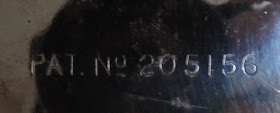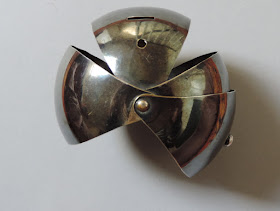A few weeks ago, I was going through some knitting and crochet patterns in the Knitting & Crochet Guild collection that were free with newspapers or women's magazines when I came across a 1930s leaflet for an attractive cardigan with an interesting collar in garter stitch, and crocheted buttons. It was one of a series of six that were given away free with successive issues of
Home Journal in October/November 1937, though this is the only one of the six that we have in the KCG collection.
It occurred to me that I didn't know anything about
Home Journal, unlike more familiar titles such as
Woman's Weekly,
Home Chat,
Home Notes. (There were probably dozens of women's magazines published in the 1930s, and there wasn't a lot of variety in the titles - which struck me when I first started sorting them out, and wrote a post about them
here.
)
We have two issues of the magazine itself in the collection, from March 1935, with the usual mixture of fiction, cooking, beauty, needle crafts, and articles about the lives of royalty and Hollywood stars. From these issues, I knew that
Home Journal was published by the Amalgamated Press, one of the giants of magazine publishing.
For more information about
Home Journal, I turned first to
The Business of Women's Magazines, by Braithwaite and Barrell, which is my usually reliable source for 20th century women's magazine history. But no luck -
Home Journal is not mentioned. The British Library catalogue was more helpful, and told me that it was published from 1934 to 1939, when it was incorporated into
Woman's Pictorial, another Amalgamated Press weekly.
I also searched the newspapers in FindMyPast, and found an ad for the first issue of
Home Journal, from March 1934:
"What a beautiful paper!" That's the first comment of everyone privileged to see the first copies of the new HOME JOURNAL; it is a spontaneous tribute to the most artistically printed and produced paper for women yet published.
HOME JOURNAL is beautiful—and it is practical and entertaining, too. Absolutely in tune with all women's interests of to-day. Therefore it is up-to-the-minute in fashion, up-to-date in ideas, bright and refreshing to read; the ideal weekly magazine for women who appreciate the good things of this world in dress, beauty, health, fiction, films and knitting. No woman can afford to miss HOME JOURNAL.
Why not get a copy now, before the rush comes - for there will be a rush!
Frock pattern and 100 embroidery transfers free in every copy.
Here's the front cover of
Home Journal from March 23rd 1935. It doesn't make me say "What a beautiful paper!", but the quality of printing is very good, and the paper is much smoother than say
Woman's Weekly at that date. (The photo is of Evelyn Laye and Frank Lawton, British stage and screen actors who were married to each other.)
 |
| Home Journal, March 23rd 1935. |
The ad also describes it as "the NEW ALL PHOTOGRAVURE Weekly Magazine for women", 3d. every Wednesday. I went back to Braithwaite and Barrell at that point, because they have a section on photogravure, which they describe as a new standard of printing "that would almost overnight make the pulp weeklies look very drab". They say that photogravure is an expensive process to set up, but becomes more economical with very large print runs. Their account gives the credit for the first women's magazine to be completely produced by photogravure to
Woman, launched in 1937. Though if the 1934 ad is correct, it seems that actually
Home Journal was there first.
An article in the Sheffield Independent in March 1934 suggests that the Amalgamated Press were aiming at a very high circulation for
Home Journal:
"HOME JOURNAL" SUCCESS
The new weekly paper for women — "Home Journal"—has been welcomed everywhere. So great was the demand for copies that the first edition of 300,000 was sold out on the first day. A second edition of 100,000 was printed and distributed in record time for a magazine of such beauty and artistic merit.
This, too, was soon swapped up and within 48 hours of this magazine's first appearance practically every copy printed had been sold. It is, without doubt. a record in the history of publishing for 400,000 copies of a threepenny weekly magazine of the character of "Home Journal" to be sold in less than two days.
(This purports to be independent reporting, but I suspect it was based on a press release, or even paid for.) I don't know why the magazine was merged with
Woman's Pictorial in 1939. Perhaps the circulation wasn't large enough to make it economical, or if the merger happened late in the year, it might be that Amalgamated Press decided to reduce the number of titles in anticipation of shortages of paper due to the war.
So what about knitting? There is a knitting pattern in both issues that we have. In the March 1935 issue, there is a jumper in stocking stitch, with chevrons back and front in garter stitch.
 |
| Knitted jumper pattern from Home Journal, March 23rd 1935. |
The other issue in the KCG collection has a knitting pattern illustrated on the front cover:
 |
| Home Journal, March 2nd, 1935 |
The jumper was knitted in a wool-rayon yarn called 'Sheenella', and has bands of moss stitch separated by double rib - though the main feature is the big bow, of course.
I think it's likely that there was a knitting or crochet pattern in every issue. But the magazine seems to have been lavish with free gifts, which sometimes, as in 1937, were knitting patterns in free leaflets or gift books. As well as the leaflet illustrated at the top, we have a gift book of "Quickly Knitted Designs", given free with an issue of
Home Journal (undated). Like the magazines themselves, the pattern leaflet and the gift book are good quality publications. At the time, Patons & Baldwins leaflets, to a similar standard, cost 2d., so a free leaflet with a 3d. magazine was a bargain, a gift book with several patterns included even more so. And they are very stylish designs. If you like 1930s knitwear, they are very attractive - though the patterns would need adapting for most of us. The jumpers illustrated are all designed for a 34 in. bust, so a UK size 10. Worth the effort of adapting a pattern if you're a 1930s fan.
I'll write about the "Quickly Knitted Designs" gift book another time.

















